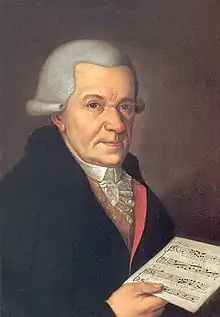| Missa tempore Quadragesimae | |
|---|---|
| Mass by Michael Haydn | |
 The composer of the Mass for Lent | |
| Key | D minor |
| Catalogue | MH 553 |
| Form | Missa brevis |
| Occasion | Lent, also Advent |
| Text | Mass ordinary without Gloria |
| Language | Latin |
| Composed | 1794 |
| Published | c. 1820: Augsburg |
| Movements | 4 |
| Vocal | SATB choir |
| Instrumental | organ |
The Missa tempore Quadragesimae (Mass for the time of Lent), Klafsky 1:19, MH 553, is a mass without a Gloria by Michael Haydn. The work in D minor was written in 1794 in Salzburg, scored for a four-part choir and organ.[1] It is suitable also for Advent.[2]
History
Michael Haydn composed the mass as a director of music in Salzburg under archbishop Colloredo.[3] According to a recording's notes, the "Missa is perfectly in accord with the then current ideals for reform in the Catholic Church: functional, short, simple, modest and linked to the Gregorian tradition."[4]
Scoring and structure
The autograph is titled: "Missa, tempore Quadragesimae. à 4 Voci in pieno, col Organo. Di Giov: Michele Haydn" (Mass for Lent for four voices, with organ by Giov. Michele Haydn).[5] In the following table of the movements, the markings, keys and time signatures are taken from the choral score of the Carus edition, using the symbol for alla breve (2/2).[1]
| Part | Incipit | Marking | Key | Time |
|---|---|---|---|---|
| Kyrie | Kyrie | Un poco Allegretto | D minor | 6/8 |
| Credo | Credo | Vivace | D minor | |
| Et incarnatus est | Corale. Adagio | free | ||
| Et resurrexit | Allegro | 3/4 | ||
| Sanctus – Benedictus | Sanctus | Larghetto | D minor | |
| Benedictus | Andante | F major | ||
| Agnus Dei | Agnus Dei | Adagio | D minor | 3/4 |
Publication
The mass was first published around 1820, possibly 1827, in Augsburg by Anton Böhme, titled Missa in tempore Adventus et Quadragesimae and supplemented by J. Eybler, who added a Gloria and a second Et incarnatus. It appeared in Vienna in 1915, edited by Anton Maria Klafsky, in Denkmäler der Tonkunst in Österreich, volume 45, by the Österreichischer Bundesverlag.[2]
Recordings
The mass was recorded in 2006 by the Ex Tempore choir, conducted by Florian Heyerick, together with other works by the composer. A review notes its "beautiful, concise soberness unlike anything in the Mozart oeuvre or that of anyone else",[6] pointing at the section "Et incarnatus est" which is free in tempo, similar to harmonized chant.[1] The mass was recorded in 2008 by the Purcell Choir, conducted by György Vashegyi, combined with other lenten music by the composer, titled Sacred music for the season of Lent.[7] A reviewer notes the homophonic setting and simple rhythm, resulting in a floating meditative sound.[8]
References
- 1 2 3 Sherman, Charles H., ed. (1995). Michael Haydn: Missa Tempore Quadragesimae. Carus-Verlag.
- 1 2 "Missa in tempore Adventus et Quadragesimae". eybler-edition.org. Neuausgaben. Retrieved 30 November 2014.
- ↑ Veen, Johan van. "Johann Michael Haydn (1737–1806) / Vocal and Instrumental Works". musicweb-international.com. Retrieved 29 November 2014.
- ↑ "Vocal & Instrumental Works – J.M.Haydn". etcetera records. Retrieved 29 November 2014.
- ↑ Haydn, Michael / Masses in D minor. opac.rism.info. Retrieved 30 November 2014.
- ↑ Manheim, James. "Johann Michael Haydn: Vocal & Instrumental Works". Allmusic. Retrieved 29 November 2014.
- ↑ "Sacred music for the season of Lent". search.library.wisc.edu. Retrieved 30 November 2014.
- ↑ Kerkhoff, Sven. "Johann Michael Haydn: Vocal & Instrumental Works". Allmusic. Retrieved 29 November 2014.
Sources
- Missa tempore Quadragesima, MH 553: Scores at the International Music Score Library Project
- Johann Michael Haydn: Missa Tempore Quadragesimae Carus-Verlag
- Missa tempore Quadragesimae : MH 553 (1794) : à 4 voci in pieno, col'organo : per coro SATB, organo e violone / Michael Haydn; herausgegeben von Charles H. Sherman. franklin.library.upenn.edu